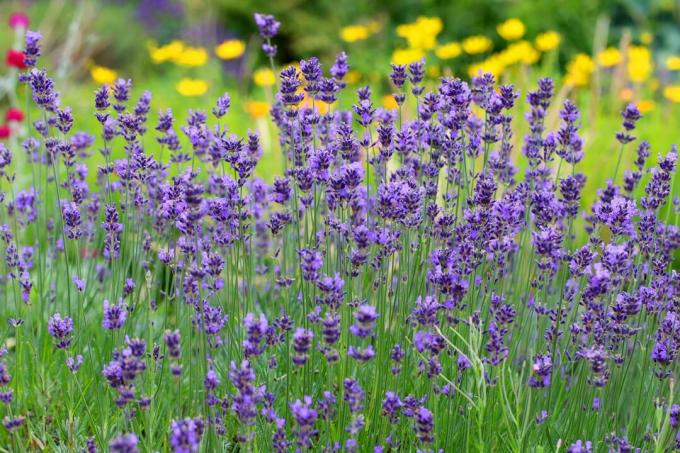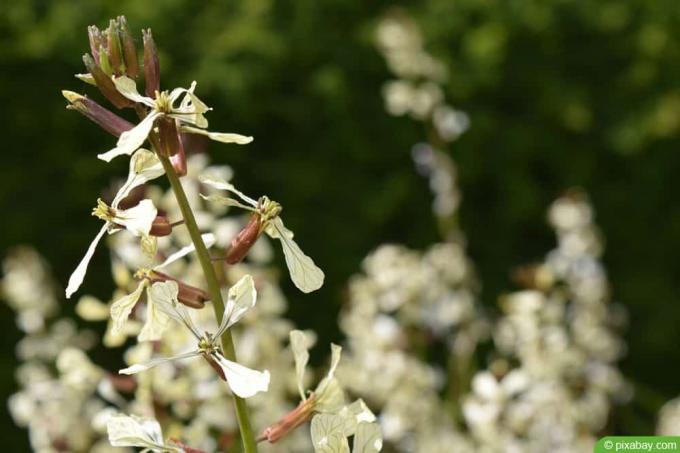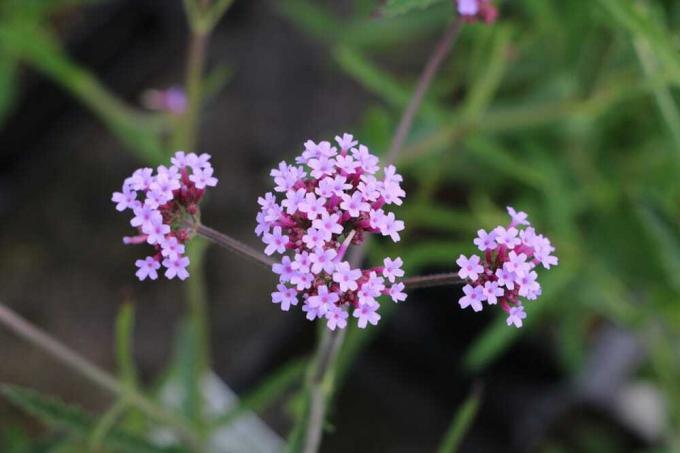

Table of contents
- Adjust site conditions
- Avoid care mistakes
- detect fungal infestation
- Squirt milk solution
- Use garlic tea
- identify pests
- Spray rapeseed oil solution
- Spray soapy solution
Rosemary is a popular culinary herb, the leaves of which are used in Mediterranean dishes because of the essential oils. Mottled discolorations indicate suboptimal conditions or are caused by fungal and pest infestation.
Adjust site conditions
The evergreen shrub has its natural distribution area in the dry and hot regions of the Mediterranean. Rosemary is a survivor, found in barren locations and tolerates heat. In the Mediterranean region, the species grows predominantly in coastal regions and is an integral part of evergreen scrub vegetation known as maquis. It can also be found in shrub heath landscapes on shallow soils, the so-called garigues. If the microclimate is too humid or the growing area too cool, various problems such as spots on the leaves can occur. The first measure to improve disease progression and eliminate pests is a change of location. In the garden, the herb prefers the following conditions:
- areas in full sun and sheltered from the wind that offer plenty of warmth
- loose substrate that can be stony and calcareous
- moderately dry condition
Avoid care mistakes
With its growth, rosemary has adapted to the extreme climate in the natural distribution area. The evergreen plant benefits from winter rainy periods. To protect itself against the hot and dry summer months, it has developed strikingly narrow leaves with the edges curled downwards. The upper surface is covered by a thick epidermis while whitish to gray felt hairs appear on the underside. These adjustments prevent the herb from losing too much water. If it is cared for incorrectly, the health of the plant will be impaired. Weakened plants are more susceptible to pathogens and insect pests that cause white spots. Therefore, you should pay attention to an adapted care:
- do not allow waterlogging to occur
- Outdoor plants do not require additional nutrients
- Potted plants enjoy an occasional dose of liquid fertilizer
- generally avoid fertilizing after August
- repot older specimens as little as possible
- Cut back all previous year's shoots to short stubs at the end of March
Tip:
Even if the herb prefers dry conditions, occasional watering makes sense. This ensures that the intensive aroma is retained in the leaves.
detect fungal infestation

If the leaves have a floury coating on the upper side of the leaf that can be easily wiped off with a finger, the plant is infected with powdery mildew. This fungal disease is particularly common in potted plants that are cultivated indoors all year round or that are overwintered too warm. Since powdery mildew prefers warm and dry conditions, it is considered a fair-weather fungus. If the fungus spreads freely on the plant, it will affect the health of the plant. An untreated fungal disease can lead to excessive leaf loss because the fungal mycelium penetrates the leaf tissue and robs it of nutrients.
Squirt milk solution
A watery milk solution helps with mild mildew infestation. The lecithin it contains prevents the fungal network from penetrating the leaf cells. In addition, the lactic acid bacteria create an unfavorable environment in which the spores do not feel comfortable. Sodium phosphate strengthens the plant's defences, so that you can prevent re-infestation at the same time. For the greatest possible success, the entire plant must be sprayed dripping wet, because the home remedy only works in direct contact. Follow these steps:
- mix fresh raw or whole milk with water (ratio 1:8)
- alternatively use whey or buttermilk
- Pour mixture into a spray bottle
- Spray rosemary two to three times a week
Use garlic tea
Garlic contains sulfur-containing compounds, which convert to allicin when the cloves are cut. This substance has cell-killing properties and acts as a natural fungal toxin. It is important that you spray all affected parts of the plant with the brew. Repeat the action three to four times a week. How to create the excerpt:
- Crush 50 grams of garlic cloves
- pour over a liter of cooking water
- leave at room temperature for a day
- Dilute broth with water (ratio 1:10)
A notice:
If the fungus has spread a lot, only a radical pruning usually helps. While neem oil-based fungicides are effective, they should not be used on kitchen herbs.
identify pests
Many insects have stinging mouthparts that they use to penetrate the pathways in plant tissue and feed on the sap. Discolouration occurs at these puncture sites, the intensity of which depends on the extent of the infestation. If a pest infestation is not combated in time, the spots expand and merge with each other. The foliage dries up and falls off. These harmful insects often occur on rosemary:
- leafhoppers: provide yellowish to white stippling on outdoor plants during the summer
- spider mites: cause yellowish-white spots on potted plants in winter quarters
- white flies: appear as white dots and leave yellowish discolouration on the underside of the leaf
Tip:
Leafhoppers are very agile and difficult to control because they quickly flee when touching the plant. Spray the rosemary with a heavily diluted vinegar essence, because this smell has a deterrent effect.

Spray rapeseed oil solution
Oil covers the harmful insects like a film and clogs their respiratory pores. Even the well-hidden eggs die off when there is a lack of air. Since the oil particles settle in the stomata of the leaves, you should spray the treated plants vigorously with dishwater (mix water with dishwashing liquid) after a day. Reapply the remedy at regular intervals until the infestation disappears. You have to consider this during production:
- Mix ten milliliters of rapeseed oil with half a shot glass of dish soap
- Whisk with an immersion blender and slowly add water
- Mix until a total of one liter of tap water has been mixed in
- Fill into a spray bottle and spray onto the affected parts of the plant with a fine atomizer
Spray soapy solution
Similar to spraying with rapeseed oil-based mixtures, the soapy water also forms an airtight film on the leaves. The addition of alcohol makes the substance more aggressive because it damages the outer skin of the harmful insects and causes them to dry out. This agent is gentler on the plant, because the soap film decomposes quickly due to the effects of the weather and the alcohol evaporates quickly. This is how it's done:
- Dissolve 15 grams of soft soap in one liter of water
- Add 50 milliliters of spirit
- Pour into an atomizer bottle and spray onto the plants
Tip:
Plant manure with stinging nettle and horsetail strengthens the cell tissue after spraying and acts to a small extent against the pests themselves.
 Home editorial office
Home editorial office
Learn more about garden herbs

Lady's mantle: 9 tips for planting, caring for and cutting
The lady's mantle can be found in almost every garden. There are around 1,000 different species. Here's the best time to plant it and how to care for it. it is also clarified whether and how it has to be cut.

Lavender, Lavandula angustifolia: 14 tips of care
Compared to other lavender varieties, Lavandula angustifolia is hardy down to temperatures of -15°C. In addition, he does not place very high demands on the location. It only needs to be sunny and sheltered from the wind and it loves lean, well-drained and calcareous soil.

Rocket is blooming: is it still edible when blooming?
Rocket, also known as rocket, is a traditional cultivated plant that has been somewhat forgotten in recent years. It is now back in fashion and can be found in numerous dishes as a raw vegetable salad, side dish or herb.

Make your own mint tea – What is the effect of fresh mint tea?
Mint tea tastes best when you brew it from freshly picked mint leaves. In this way, the aromatic herb unfolds its healing effect against all kinds of ailments. However, there are also contraindications, because fresh mint tea can also have undesirable side effects.

Harvest peppermint when it blooms? | What to watch out for with mint
Due to its spicy flavor and easy-care properties, peppermint has become widespread in the local latitudes. Only the leaves need to be harvested for consumption. However, there are a number of factors to consider during the flowering period, as the flavor then changes significantly.

c: Profile | Caring for and harvesting verbena
Verbena has established itself as a popular plant in the local latitudes thanks to its strong growth potential and long-lasting flowering period. In addition to a distinctive appearance, the plant known as Verbena also has healing properties. This places certain demands on care and location.



